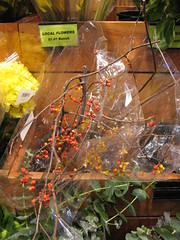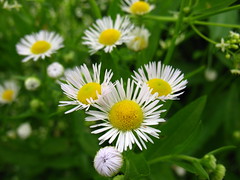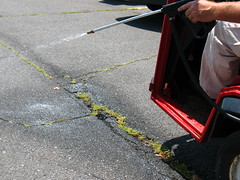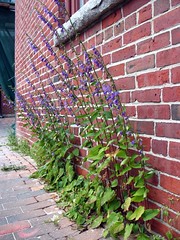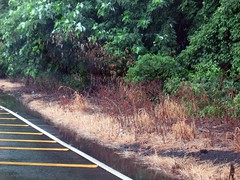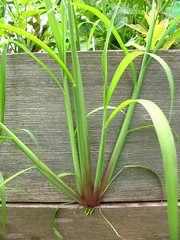Jane Kramer writes about her foraging adventures in Europe in The New Yorker article The Food at Our Feet. On the New York Times blog City Room, they have a series in Urban Foraging by Ava Chin, writing about purslane picked from the sidewalks of the city, and much more.
Ecologists have started to argue scientifically about if alien species are necessarily bad or not. It started with an article in Nature (subscription only, so no link, but find it by googling 'doi:10.1038/474153a') by Mark Davis and 18 other ecologists. This led to a bumper crop of protest letters from many other ecologists (see the issues afterwards in Nature), and it entered the popular media too. Here is a podcast from Radio Australia about it.
In an article in TIME magazine, Bryan Walsh ponders if 'In a Globalized World, Are Invasive Species a Thing of the Past?'
Wired adds to the pile, with 'Sometimes Invasive Species are Good'. Wired goes on to describe 9 invasive species worth admiring, including the dandelion weed.
Welcome to the wonderful world of weedy plants!
Weeds are superevolutionary products of human civilizations and activities - without humans there would be no weeds, just wild plants.
Monday, December 19, 2011
Sunday, December 18, 2011
Local Flowers for $7.41 per branch!
The only problem here is that the local flowers are the invasive species Oriental bittersweet, Celastrus orbiculatus, which we rather get rid of. I bet the florist didn't know this. But this is a great use for an alien, invasive weed, don't you think? And to have some people pay over $7 for a branch of unwanted stuff, that is pretty good too. Of course most of them could have gone to any nearby place and cut this down themselves, since this species is omnipresent, fortunately.
Wednesday, December 7, 2011
Species: Mile-a-Minute weed

Mile-a-Minute weed, Polygonum perfoliatum / Persicaria perfoliata, Polygonaceae, a photo by Vilseskogen on Flickr.
(Polygonum perfoliatum = Persicaria perfoliata, Polygonaceae)
Monday, December 5, 2011
What agriculture really is about...
Farms are captive breeding facilities for evolutionarily unfit plants.
- Ari Novy
Monday, October 17, 2011
Pooh got it right
"Weeds are flowers too, once you get to know them." - A.A. Milne
Friday, October 7, 2011
Some more weed quotes
Our attitude towards plants is a singularly narrow one. If we see any immediate utility in a plant we foster it. If for any reason we find its presence undesirable or merely a matter of indifference, we may condemn it to destruction forthwith.
Rachel Carson
What would become of the garden if the gardener treated all the weeds and slugs and birds and trespassers as he would like to be treated, if he were in their place?
Thomas Henry Huxley
One is tempted to say that the most human plants, after all, are the weeds.
John Burroughs, Pepacton, 1881
"And so it criticized each flower,
This supercilious seed;
Until it woke one summer hour,
And found itself a weed."
Mildred Howells, The Different Seed
A good garden may have some weeds.
Proverb
Weeds are nature's graffiti.
Janice Maeditere
Weeds Never Die.
Danish Proverb
Rachel Carson
What would become of the garden if the gardener treated all the weeds and slugs and birds and trespassers as he would like to be treated, if he were in their place?
Thomas Henry Huxley
One is tempted to say that the most human plants, after all, are the weeds.
John Burroughs, Pepacton, 1881
"And so it criticized each flower,
This supercilious seed;
Until it woke one summer hour,
And found itself a weed."
Mildred Howells, The Different Seed
A good garden may have some weeds.
Proverb
Weeds are nature's graffiti.
Janice Maeditere
Weeds Never Die.
Danish Proverb
Sunday, September 11, 2011
What a name: fleabane
Gorgeous weed in the sunflower family (Asteraceae) with a very weedy name: daisy fleabane. It is a member of the very large genus Erigeron, and the species is Erigeron annuus. Each white ray and each little yellow dot is an individual flower, so what looks like one flower is actually hundreds of flowers in a head, which is typical for the sunflower family.
It has been used to repel insects (therefore fleabane!), and also for many other medicinal purposes. This photo is from southern New York State, but it is a common weed in most parts of the United States.
It has been used to repel insects (therefore fleabane!), and also for many other medicinal purposes. This photo is from southern New York State, but it is a common weed in most parts of the United States.
Sunday, August 14, 2011
Spraying against weeds with Round-Up
On a Rutgers parking lot, I caught this scene a few weeks ago. I wonder, why do we really have to kill these poor little carpetweeds and other weeds? It is not like the car tires will slip on them, right? It is all because we think green on the black will look bad? Look untended and dirty?
Weed soda?
Yes, in England. Fentiman's produces a soda made with dandelion leaves (Taraxacum) and burdock roots (Arctium). It is apparently a traditional English favorite. I will have to ask my UK friends about this.
They also have Ginger Beer that includes yarrow (Achillea) and their Orange Soda has speedwell (Veronica) in it. Gloriously weedy, indeed.
They also have Ginger Beer that includes yarrow (Achillea) and their Orange Soda has speedwell (Veronica) in it. Gloriously weedy, indeed.
A weed killer is banned
"The Environmental Protection Agency banned the sale on Thursday of Imprelis, a weed killer introduced this year that landscapers link to thousands of tree deaths around the country." (source: New York Times, August 11, 2011)
Another pesticide is banned from lawns and turf areas after killing of the trees nearby.
"While it has been highly effective at killing clover and broad-leafed weeds like dandelions, landscapers say, nearby evergreens in many cases began dying within weeks of the first applications. Some agricultural experts have suggested that the tree toll could reach into the hundreds of thousands."
Imagine how much it would cost to replace (which you really can't) a big old spruce or douglas fir. In the article they say up to $25,000. Wouldn't you rather have some dandelions and clovers AND your tree alive? I just don't get the need people have to have a weed-free lawn, a rather sterile environment just of spiky grass leaves. Certainly, our pursuit of neatness and control in our gardens brings us more and more toxins and deaths.
Now I wonder how many of the dead conifers you see around here in New Jersey after last summer's drought might have been from landscapers spraying Imprelis on the ground around them.
Monday, August 8, 2011
Urban weed: Campanula rapunculoides
A very crowded place to live for a weed, between a brick and a brick, in Portland, Maine.
Monday, August 1, 2011
Weed Quote: Thomas Fuller, 1732
A good garden may have some weeds.
~Thomas Fuller, Gnomologia, 1732
~Thomas Fuller, Gnomologia, 1732
Richard Mabey's book reviewed in NY Times
The book WEEDS: in Defense of Nature’s Most Unloved Plants by Richard Mabey is reviewed in New York Times today. It is great review, but once again there is a common mistake in how evolution works by the writer of the review (and maybe also by Mabey, I am not sure since I haven't read the book yet):
"One can’t help being impressed by weeds’ ingenuity. They’ve grown hooks, burrs, spines, rib hairs and a sort of glue to move their seeds around."
Weeds haven't grown these things. Plants that had these characters, evolved from genetic variation and mutations over a long time, became weeds because of them. To become a weed is a secondary thing, not something that forces a plant in a certain evolutionary direction.
It is interesting though how our weed project hits exactly the same notes as Mabey's book. History, culture, biology, medicine, and the misunderstood weeds connecting it all.
Labels:
book,
book review,
dispersal,
evolution,
fruits,
killing,
news,
seeds,
united kingdom
Sunday, July 31, 2011
Flower bombs
A UK company has invented and are selling a fantastic idea: flower bombs. They are clay hand grenades filled with flower seeds that you can launch into abandoned urban plots. Interestingly enough the seeds in the bomb are three species often considered to be weeds (but not invasive): poppies (Papaver), buttercups (Ranunculus), and ryegrass (Lolium). All three will self-seed.
Labels:
abandoned,
design,
guerilla gardening,
product,
united kingdom,
urban,
war,
weapon,
weeds
Saturday, July 30, 2011
No more foraging in NYC parks
An article in today's New York Times describes how the park department is planning to crack down on foraging for edible plants (and animals) in the city's parks.
Not all are weeds of course, but many are, and some are also invasive. Personally I think a total ban is wrong, because I want kids to pick a raspberry, and if the Chinese want to gather the smelly ginkgo fruits, let them! And if the "edible weeds crowd" want to reduce the invasive Japanese knotweed by cutting the young edible spring shoots, that is certainly better than spraying with pesticides later. But hauling turtles out of the park is a different thing. So as usual, the issue is not as straightforward or black and white as we would like it to be. It always amazes me that it is illegal to pick mushrooms in America's National Parks for example. Is it better that the mushrooms rot away? I think it is better that people get closer to nature understand its value, limitations and dangers than that we coop up nature behind laws and bars and signs that tells us to stay away from all green things.
"....New Yorkers are increasingly fanning out across the city’s parks to hunt and gather edible wild plants, like mushrooms, American ginger and elderberries. Now parks officials want them to stop. New York’s public lands are not a communal pantry, they say." (source)
Not all are weeds of course, but many are, and some are also invasive. Personally I think a total ban is wrong, because I want kids to pick a raspberry, and if the Chinese want to gather the smelly ginkgo fruits, let them! And if the "edible weeds crowd" want to reduce the invasive Japanese knotweed by cutting the young edible spring shoots, that is certainly better than spraying with pesticides later. But hauling turtles out of the park is a different thing. So as usual, the issue is not as straightforward or black and white as we would like it to be. It always amazes me that it is illegal to pick mushrooms in America's National Parks for example. Is it better that the mushrooms rot away? I think it is better that people get closer to nature understand its value, limitations and dangers than that we coop up nature behind laws and bars and signs that tells us to stay away from all green things.
Labels:
edible,
foraging,
invasive,
killing,
New York City,
news,
parks,
public space
Friday, July 29, 2011
Vinegar and hot water
Two really good ways to kill any plant, weed or not, is to either pour boiling water over it or spray it with vinegar. It works. Here is a link to a vinegar killing evaluation, and the boiling water I have used myself. Just boil some water in a tea kettle and then pour it over the weeds in the driveway. Much better than store-bought chemicals.
Labels:
gardening,
home remedies,
killing,
pesticides,
removal,
weeds
After the spraying....
...the roadside is no longer alive. Seen in Franklin Township, along Cozzens Lane.
Friday, July 8, 2011
Richard Mabey interview on NPR
British author Richard Mabey was interviewed by NPR about his new book and it was aired yesterday. He has a refreshing take on weeds, or as NPR phrases it: "In Defense Of Botany's Cockroach". I am not sure I would call weeds cockroaches at all, because first weeds do usually not live inside our houses, and second, do not usually run over our foods and clean counters and spread germs and disease. Weeds are a lot better than cockroaches. They are more interesting too, and I say this from personal experience after living in a cockroach infested apartment in the Bronx in the 1990s. (We had mice, bats, snakes and squirrels intermittently in the apartment too, but that is another story for another time).
Read the interview, is is great. Mabey also correctly points out that the most weedy species on earth is in fact, us humans:
"And while many might think of them as pests, British nature writer Richard Mabey prefers to think of them as "vegetable guerrillas" and "forest outlaws." Mabey's new book, Weeds: In Defense of Nature's Most Unloved Plants, is a spirited defense of weeds."
Read the interview, is is great. Mabey also correctly points out that the most weedy species on earth is in fact, us humans:
"Weeds, as a type, are mobile, prolific, genetically diverse. They're unfussy about where they live, adapt quickly to environmental stress, use multiple strategies for getting their own way," Mabey writes in his book. "It's curious that it took us so long to realize that the species they most resemble is us."
Thursday, July 7, 2011
Squeezed barnyardgrass
This annual grass plant (barnyardgrass, Echinochloa crus-galli) is really in a tight spot, on the wall of a raised bed. But it is doing great, after managing to sink at least some of its roots into the soil on the other side of the boards through the tiny crack.
Species: barnyardgrass, Echinochloa crus-galli, Poaceae
Species: barnyardgrass, Echinochloa crus-galli, Poaceae
Labels:
gardening,
grass,
New Jersey,
photo,
raised bed,
roots,
weeds
Friday, July 1, 2011
What is a weed anyway?
Any plant can be a weed, it just depends on the local circumstances. There is no special biological attribute that makes a plant a weed. Weeds are just plants we (humans) do not want at that particular place. This could be because we are trying to grow something else, that we think they look ugly, they might be poisonous, the might take over and crowd out other plants and change the ecosystem habitat, or we might think they are just wrong.
Weeds are a human mental construct - without human agriculture and horticulture or dwellings on earth there wouldn't be any weeds. There would just be plants...
So, in our rather selfish pursuits we tell the plants that like to live in 'our' places, that they are unwanted (=weeds) and should be eradicated.
Weeds are a human mental construct - without human agriculture and horticulture or dwellings on earth there wouldn't be any weeds. There would just be plants...
So, in our rather selfish pursuits we tell the plants that like to live in 'our' places, that they are unwanted (=weeds) and should be eradicated.
Some definitions:
A plant that is not valued where it is growing and is usually of vigorous growth; especially one that tends to overgrow or choke out more desirable plants.
A plant considered undesirable, unattractive, or troublesome, especially one growing where it is not wanted, as in a garden.
A valueless plant growing wild, especially one that grows on cultivated ground to the exclusion or injury of the desired crop. Any undesirable or troublesome plant, especially one that grows profusely where it is not wanted.
Any plant that is growing in a place where a human wants a different kind of plant or no plants at all.
Any plant growing where it is not wanted.
A wild plant growing where it is not wanted and in competition with cultivated plants.
Tuesday, June 14, 2011
Why We Must Learn to Love Weeds
On June 4, Wall Street Journal published an interesting, great and refreshing article on weeds by Richard Mabey, titled "Why We Must Learn to Love Weeds". It highlights that what is a weed in one place can be a beloved plant in another, so the tag 'weed' depends on circumstances and not a specific species. Houston in Texas, USA, has even tried to outlaw weeds, by making weeds illegal, in their law saying:
Think about that for a while. You are outlawing plants that try to grow in or cover anything that humans have made. That really sets up the fight, man vs. weed. Since the only plants that can grow in many human-made environments are by definition weeds, this law declares war on a large branch on the Tree of Life. Is that what we want? Is that necessary? And don't we have more important things to do than spraying pesticides in artificial environments were we live?
Richard Mabey continues:
Maybe weeds follow us humans because we make places where these plants thrive? Maybe we 'make' the weeds? I don't think there is a botanical definition that fits all weeds, but plants that lived in disturbed ecological habitats are certainly often weeds. But even a definition as 'disturbed habitat' requires a human input, since soil disturbance due to a landslide, for example, would lead to a new succession in habitats with new pioneer plants, and not suddenly be seen as a weedy area. I think the 'weed' definition is in the eye of the beholder, in us humans.
The article addresses further our view of weeds in our cultures, how they are symbolic of evil even in childrens' books like Harry Potter and science fiction. How many of them have been or become useful plants for things like crops, medicine, or soil improvement. Weeds move around, and homogenizes an Earth we humans have changed and made less natural over the last centuries.
Richard Mabey really puts the weeds into a wider perspective in this article which is an excerpt from his new book (which I will have to get). He ends his article:
So true! Every aspect of natural and human life you can find examples of in weeds, even politics. Read the article, it is excellent.
"the existence of weeds, brush, rubbish and all other objectionable, unsightly and unsanitary matter of whatever nature covering or partly covering the surface of any lots or parcels of real estate."
Think about that for a while. You are outlawing plants that try to grow in or cover anything that humans have made. That really sets up the fight, man vs. weed. Since the only plants that can grow in many human-made environments are by definition weeds, this law declares war on a large branch on the Tree of Life. Is that what we want? Is that necessary? And don't we have more important things to do than spraying pesticides in artificial environments were we live?
Richard Mabey continues:
"All of these definitions view weeds entirely from a human perspective. They are plants that sabotage human plans. [...] But is it conceivable that they might also have a botanical, or at least an ecological, definition?"
Maybe weeds follow us humans because we make places where these plants thrive? Maybe we 'make' the weeds? I don't think there is a botanical definition that fits all weeds, but plants that lived in disturbed ecological habitats are certainly often weeds. But even a definition as 'disturbed habitat' requires a human input, since soil disturbance due to a landslide, for example, would lead to a new succession in habitats with new pioneer plants, and not suddenly be seen as a weedy area. I think the 'weed' definition is in the eye of the beholder, in us humans.
The article addresses further our view of weeds in our cultures, how they are symbolic of evil even in childrens' books like Harry Potter and science fiction. How many of them have been or become useful plants for things like crops, medicine, or soil improvement. Weeds move around, and homogenizes an Earth we humans have changed and made less natural over the last centuries.
Richard Mabey really puts the weeds into a wider perspective in this article which is an excerpt from his new book (which I will have to get). He ends his article:
"Weeds are, in this sense, paradoxical. Although they follow and are dependent on human activities, their cussedness and refusal to play by our rules makes them subversive—and the very essence of wildness."
So true! Every aspect of natural and human life you can find examples of in weeds, even politics. Read the article, it is excellent.
Labels:
book,
children's book,
definition,
disturbance,
ecology,
evil,
law,
literature,
news,
pesticides,
science fiction,
wilderness
Thursday, June 2, 2011
Lucy in the sky with dandelions
You don't often see dandelion (Taraxacum officinale, Asteraceae) featured in contemporary art, but here is an example by Amy Jean Porter. A school girl floating free against a summer sky and with dandelions on each side. Beauty in everyday common features, maybe - from the weedy plant to the school uniform and the very common clouds. The text on the painting, "As pretty as a poem, was Mary", could be implemented as sarcasm or the truth, whichever way you want to see it. Who knows what the artist thought, but this is my take on it.
Subscribe to:
Posts (Atom)

